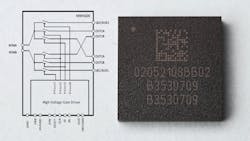DPDT Differential Switch Hammers Out 40-Gb/s Rate
With the launch of its MM5600 DPDT differential switch, Menlo Micro claims the industry’s highest performance and data rates for high-speed differential switching applications. Based on the company’s Ideal Switch technology, the MM5600 offers high-speed operation from DC to 20 GHz or 40 Gb/s, significantly outperforming conventional electromechanical (EM) relays and solid-state switches. The MM5600 switch’s flexible configuration also enables internal differential crossover capabilities, greatly simplifying board routing.
The MM5600 provides a high-performance differential switching device for high-speed digital applications based on the latest PCI Express standard, PCIe Gen 5, which doubles interconnect speeds over the PCIe 4.0 specification (32 GT/s vs. 16 GT/s). Faster PCIe speeds are essential for next-generation artificial intelligence (AI), machine learning (ML), 5G infrastructure, data center and cloud-based applications, as well as automated-test-equipment (ATE) device interface boards and high-speed computer peripheral interfaces. The MM5600 switch also can be configured for single-ended operation for RF and microwave applications.
Among the highlights of the MM5600 is its ultra-fast switching, with <10-µs operation time and <2-µs release time, said to be 1000x faster than EM relays, enabling reduced test time and cost-to-test. Additionally, the switch is rated for more than 3 billion switching cycles, which is also a 1000x improvement over the lifetime of EM relays.
The MM5600’s small-footprint/low-profile 64 mm2 design in an 8-mm x 8-mm x 1.6-mm QFN package provides a 90% size reduction compared to EM relays. The device also operates at less than 0.08 mW, a 99% reduction in power consumption compared to EM relays.
An integrated driver offers two modes of operation and can be controlled through a serial or parallel interface to drive the switch’s high-voltage gate lines. Full electrostatic-discharge (ESD) protection is included on all I/O ports.
Finally, the MM5600 achieves an IP3 linearity of more than +90 dBm with a power-handling capability of +33 dBm, enabling large reductions in distortion and delivering up to a 10,000x improvement over existing EM relays and solid-state switches. IP3 is the figure of merit in determining how much distortion a switch will introduce into a system, impacting the quality of transmitted or received signals.
Samples of the MM5600 DPDT differential switch are currently available.
About the Author
David Maliniak
Executive Editor, Microwaves & RF
I am Executive Editor of Microwaves & RF, an all-digital publication that broadly covers all aspects of wireless communications. More particularly, we're keeping a close eye on technologies in the consumer-oriented 5G, 6G, IoT, M2M, and V2X markets, in which much of the wireless market's growth will occur in this decade and beyond. I work with a great team of editors to provide engineers, developers, and technical managers with interesting and useful articles and videos on a regular basis. Check out our free newsletters to see the latest content.
You can send press releases for new products for possible coverage on the website. I am also interested in receiving contributed articles for publishing on our website. Use our contributor's packet, in which you'll find an article template and lots more useful information on how to properly prepare content for us, and send to me along with a signed release form.
About me:
In his long career in the B2B electronics-industry media, David Maliniak has held editorial roles as both generalist and specialist. As Components Editor and, later, as Editor in Chief of EE Product News, David gained breadth of experience in covering the industry at large. In serving as EDA/Test and Measurement Technology Editor at Electronic Design, he developed deep insight into those complex areas of technology. Most recently, David worked in technical marketing communications at Teledyne LeCroy, leaving to rejoin the EOEM B2B publishing world in January 2020. David earned a B.A. in journalism at New York University.

